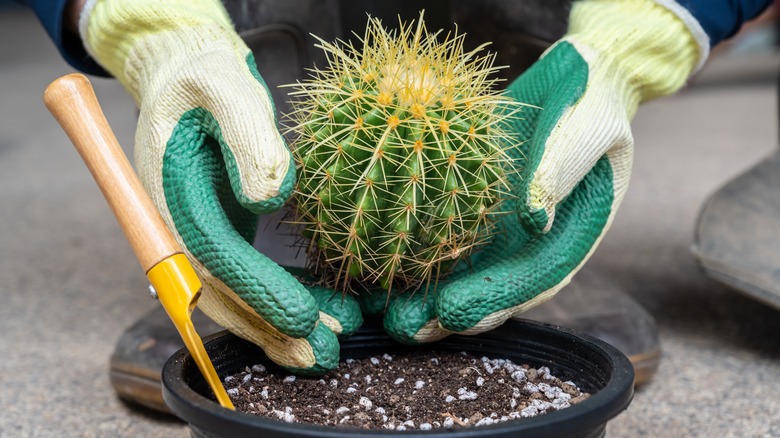Garden Trees, Shrubs & Vines
Erica Crawford
Cacti tend to be favored house plants for their low maintenance care and bohemian desert aesthetic. There are also few things more satisfying than finally watching your cactus bloom, a sure sign that you’ve been taking excellent care of it. Like every other house plant, cacti do need to be repotted to encourage healthy and full growth. They may need to be repotted less frequently than other house plants, usually once every two to four years, but the time will come.
You can identify if your cactus is ready for a new home by whether or not it’s starting to lean and become lopsided, meaning it has become too heavy and oversized for the current pot to support it. Another clear way to tell is if roots are snaking out the bottom drainage holes or if the soil hasn’t been changed in a few years and is depleted. Whether you have an angel wing cactus with thin, hair-like spines or a barrel cactus with large and fiercer spikes, you’ll need to be cautious as you transplant them so as not to hurt the plant or yourself. With the help of tools like gloves, tongs, newspaper, and towels, you’ll be able to safely repot your cactus without a single painful prick.
Tools for repotting your cactus

Boyloso/Shutterstock
The first thing you need to do before attempting to repot your cactus is to make sure you have all the necessary supplies. Of course, a new pot is in order, and you should choose one just a few inches larger than the previous one. Anything too large or too small will only hinder the plant’s growth. Terracotta pots tend to work well for cacti since they are porous and give excellent ventilation. Plastic pots will, however, retain moisture and risk root rot. Cacti prefer extremely light and aerated soils, so consider adding in sand or perlite to create a course and well-draining texture.
One of the most critical items you’ll want to have is a thick pair of gloves. Regular garden gloves may not give the level of protection you need, and fabric will penetrate easily. Gloves with leather or other dense material, like these thorn-proof cactus gloves on Amazon, will work best. You can also prepare to protect more than just your hands and look to add coverage to your wrists and forearms with these long, thorn-proof gardening gloves. Additional tools to have handy to help create a barrier between you and a cactus’s spikes include tongs, newspapers, and towels.
Safely repotting your cactus
Julia Lav/Shutterstock
Once all your supplies are gathered, begin your cactus’s repotting by adding a few inches of soil mix to the bottom of the new pot. If you have decided to use newspaper or towels, wrap it around the cactus and then use gloved hands or tongs to gently take hold of the plant’s base and wiggle the pot down and away from the roots. Remove any excess dirt sticking to the plant, and take a few moments to inspect that the roots are firm and healthy.
Place your cactus in its new pot and fill the rest of the area with soil, packing it down to ensure it is firmly supported but not too compacted to where the roots will struggle to breathe. Once the cactus is snug and settled, give it a good drink of water and let the soil completely dry out before its next watering. You’ll also want to avoid any fertilizer for the next month or so while the plant adjusts to its new space. When it is time to fertilize your cactus, use one with low nitrogen content to avoid overwhelming it. With these tips and tricks, you’ll have a happy cactus in a new home and uninjured hands to go along with it.